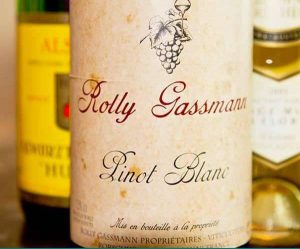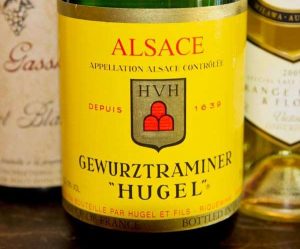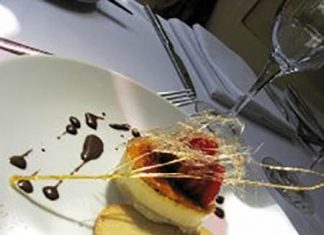
Our current Wine of the Month includes two delicious wines from the Alsace region of Eastern France.
Visit our food and drink category for some foodie inspiration
Some of you may be aware that on the previous Viewpoints & Reviews website we had included a selection of ‘special wines’ from around the world in our ‘Wine of the Month’ collection. We are hoping to start featuring them once again.
What are Alsace wines?
Sitting on the border of France and Germany, the Alsatian wines are produced from an aromatic grape varietal, and certainly one will notice a strong Germanic influence in them. Alsace is primarily known for its white grape varieties, which thrive in the region's cool climate and diverse soils. The main grape varieties used to produce Alsace wines include:
- Riesling: Considered the flagship grape of Alsace, Riesling produces aromatic, dry to off-dry wines with high acidity. These wines often exhibit flavours of citrus fruits, stone fruits, and floral notes, along with a distinct mineral character.
- Gewürztraminer: Known for its intense aromatics and exotic flavours, Gewürztraminer produces rich, aromatic wines with a hint of sweetness. Expect flavours of lychee, rose petals, spice, and tropical fruits, along with a full-bodied texture.
- Pinot Gris (Tokay d'Alsace): Also known as Pinot Grigio in other regions, Pinot Gris in Alsace produces wines with a rich, full-bodied texture and flavours of ripe stone fruits, honey, nuts, and sometimes a touch of smokiness.
- Muscat: Alsace Muscat wines are made from the Muscat grape, known for its floral aromas and fruity flavours. These wines often exhibit notes of orange blossom, grape, and citrus fruits, with a light and refreshing character.
- Sylvaner: Although less prominent than the above varieties, Sylvaner is still cultivated in Alsace and produces light, crisp wines with delicate floral and citrus notes.
- Pinot Blanc: Another lesser-known variety in Alsace, Pinot Blanc produces fresh, easy-drinking wines with flavours of green apple, pear, and sometimes a hint of spice.
- Auxerrois: Often blended with Pinot Blanc, Auxerrois produces wines with a similar profile, showcasing crisp acidity and flavours of orchard fruits.
While white grape varieties dominate Alsace, there are also some red grape varieties grown in the region, primarily Pinot Noir, which is used to produce light, fruity red wines and rosé wines. However, white wines remain the focus and speciality of Alsace.
What does Alsace wine taste like?
White Wines:
- Riesling: Alsace Rieslings are typically dry with high acidity, offering flavours of citrus fruits like lemon, lime, and grapefruit. You may also find floral and mineral notes, with some examples showing hints of petrol as they age.
- Gewürztraminer:
This wine is aromatic and often off-dry to sweet. Expect exotic fruit flavours like lychee, mango, and passion fruit, along with floral notes like rose and jasmine. Gewürztraminers from Alsace can also have hints of spice, such as ginger and cinnamon. - Pinot Gris (Tokay d'Alsace):
Alsace Pinot Gris tends to be richer and fuller-bodied, with flavours of ripe stone fruits like peach and apricot. You may also notice notes of honey, nuts, and sometimes a hint of smokiness. - Muscat:
Alsace Muscat wines are known for their floral aromas, often reminiscent of orange blossom or honeysuckle. They typically have bright, fruity flavours like grapes, citrus, and sometimes a touch of spice. - Rosé Wines:
Alsace also produces some rosé wines, primarily from Pinot Noir grapes. These rosés are usually dry and light-bodied, with flavours of red berries like strawberry and raspberry, along with floral notes. - Red Wines:
While white wines dominate Alsace, there are some red wines produced, mainly from Pinot Noir grapes. Alsace Pinot Noir tends to be light to medium-bodied, with flavours of red cherries, strawberries, and sometimes earthy or herbal undertones.
Overall, Alsace wines are often described as aromatic, elegant, and food-friendly, with a good balance of acidity and fruitiness. They pair well with a wide range of dishes, from seafood and poultry to spicy Asian cuisine.
What does an Alsace wine look like?
Alsace wines come in various styles and colours, primarily white but also including some rosé and red wines. Here's a description of what you might expect to see in each type:
White Wines:
- Riesling: Alsace Rieslings typically have a pale straw to light yellow colour in their youth, deepening to golden hues with age.
- Gewürztraminer: These wines often exhibit a deeper golden colour, ranging from pale gold to medium gold.
- Pinot Gris (Tokay d'Alsace): Alsace Pinot Gris wines can range from pale gold to deep golden or even amber hues, depending on factors such as ripeness and ageing.
- Muscat: Alsace Muscat wines tend to have a light to medium straw colour, sometimes with a slight greenish tint.
Rosé Wines:
- Alsace rosé wines, primarily made from Pinot Noir grapes, typically have a pale pink to salmon colour, with variations depending on factors such as grape skin contact and winemaking techniques.
Red Wines:
- Alsace Pinot Noir wines usually display a translucent ruby red colour, sometimes with hints of garnet at the rim, particularly as they age.
When poured into a glass, Alsace wines often exhibit clarity and brightness, with white wines showing varying degrees of transparency and red wines displaying a range of translucency. Their appearance can provide clues about their grape variety, age, and potential flavour profile.
What type of food do Alsace wines go with?
Alsace wines are incredibly versatile and can complement a wide range of foods due to their acidity, fruitiness, and aromatic characteristics. Here are some food pairing suggestions for different Alsace wine styles:
White Wines:
- Riesling: This versatile wine pairs well with a variety of dishes, including seafood (such as shellfish, sushi, and grilled fish), poultry (especially roasted or grilled chicken), pork dishes (such as schnitzel or pork chops), and Asian cuisine (such as Thai or Vietnamese dishes).
- Gewürztraminer: Its aromatic and slightly spicy nature makes it an excellent match for bold, flavorful dishes like Asian cuisine (such as spicy curries or stir-fries), dishes with exotic spices (like Indian or Moroccan cuisine), rich cheeses (such as Munster or aged Gouda), and dishes with a touch of sweetness (such as glazed ham or spicy barbecue).
- Pinot Gris (Tokay d'Alsace): This richer, fuller-bodied wine pairs well with dishes featuring creamy sauces (such as pasta with Alfredo sauce or chicken in a creamy mushroom sauce), rich cheeses (like Brie or Camembert), hearty vegetable dishes (such as gratins or vegetable lasagna), and poultry dishes with savoury herbs.
- Muscat: Its floral and fruity aromas make it an excellent match for light, fresh dishes like salads with fruit or vinaigrette dressings, seafood appetizers (such as shrimp cocktail or ceviche), light pasta dishes with seafood or vegetables, and fresh fruit desserts.
Rosé Wines:
- Alsace rosé wines, primarily made from Pinot Noir grapes, pair well with a variety of dishes, including grilled seafood, salads with grilled chicken or salmon, charcuterie boards, and lighter pasta dishes.
Red Wines:
- Alsace Pinot Noir wines can pair well with dishes such as roasted poultry (like duck or chicken), grilled salmon or tuna, mushroom-based dishes (such as risotto or mushroom tart), and charcuterie platters with cured meats.
Overall, Alsace wines offer a fantastic array of pairing options, from light and fresh to rich and flavorful dishes, making them suitable for a wide range of cuisines and occasions.
Rolly Gassmann, Pinot Blanc
 I recently tried a Rolly Gassmann, 2006 Pinot Blanc from Steve Prior the owner of Edge Restaurant in Bournemouth to see what flavours I could pick with my non-wine connoisseur nose – I found it had a Mediterranean fruitiness to it. Though this may have been the atmosphere lending to the experience (the restaurant overlooks the sea).
I recently tried a Rolly Gassmann, 2006 Pinot Blanc from Steve Prior the owner of Edge Restaurant in Bournemouth to see what flavours I could pick with my non-wine connoisseur nose – I found it had a Mediterranean fruitiness to it. Though this may have been the atmosphere lending to the experience (the restaurant overlooks the sea).
- Read more on our food and drink category
Jan Hugel, Gewurztraminer
 The second Alsace offering we have this month is the 2009 Gewurztraminer from the Jean Hugel vineyard, winemakers since as far back as 1639. Gewurz, German for spicy, rings true here, with the addition of the floral of rose and the fruitiness of citrus, banana, pear and pineapple. A rich yellow with highlights of gold, this is a highly aromatic wine.
The second Alsace offering we have this month is the 2009 Gewurztraminer from the Jean Hugel vineyard, winemakers since as far back as 1639. Gewurz, German for spicy, rings true here, with the addition of the floral of rose and the fruitiness of citrus, banana, pear and pineapple. A rich yellow with highlights of gold, this is a highly aromatic wine.
A great accompaniment to Asian and Indian food, it is a great partner for most spicy dishes as well as smoked fish and is superb with Munster and/or Roquefort cheese. Foie Gras (ethically sourced, of course) will get a boost from this wine which may also be enjoyed as an aperitif and/or a dessert wine.
I hope that you will enjoy the wine selections we have chosen and look forward to hearing your feedback and comments in the weeks and months to come.
Happy tasting!





